You are using an out of date browser. It may not display this or other websites correctly.
You should upgrade or use an alternative browser.
You should upgrade or use an alternative browser.
YES!!!! Nubia-Kemet (aka Egypt) Is Where We ("Niger-Congo"-Bantus) Came From..Own It
- Thread starter Asante
- Start date
More options
Who Replied?Charles de Brosses was also noting similarities between West African spiritual beliefs and systems, and Ancient Egypt back in 1760 (About the cult of fetish gods, or, parallel of the ancient religion of Egypt with the actual religion of Nigritia). Haven't had the opportunity to read his book yet.
I'm always quoting this bit too, which Cheikh Anta Diop and others weren't even aware of when they found the relationships we're talking about:
Similar accounts can be found across many West African groups.
I think the main issue when it comes to migration history is that people can't help but seem to think in absolutes. Groups of Ancient Egyptian migrating and mixing with/assimilating into local West African populations is not far-fetched. It doesn't have to be "West Africa was empty and then the Ancient Egyptians came and populated it".
It's more subtle than that.
I think the fact that this is even deemed not plausible is the impacts of White Supremacy. Macedonians, Romans, and Greeks were able to traverse and sail their known world and trade with others but did Africans? Nooooo. Kemet influencing or being influenced by other African civilizations is just looked upon as so far fetched which is BS.
The Wall Is Undefeated!
Superstar
The ancient Kemites or iKami migrated into inner Africa (West, Central, South Africa, America) after the Persian invasion. I took time to lay out the context to this history in the thread below. Please show it some love!
https://www.thecoli.com/threads/the...iaspora-blacks-african-origins-of-civ.777687/






My god you're a fukking dumb and deceitful clown.
1. How is America in Inner Africa!?
2. The Bantu migrated into West Africa yet there are no Bantu languages in West Africa.
3. The Bantu Migration 3000 - 4000 years ago. Conquest of Egypt by the Persian Achaemenid Empire ~2500 years ago. The dates don't match.
4. The Niger-Congo people left Egypt ~2500 years ago yet they grew none of the crops that Ancient Egyptians were known for. What happened, did the Ancient Egyptians just forget how to grow Niger-Congo crops like Millet, Cowpea, Yams, Rice, Melegueta Pepper etc once the Niger-Congo people left!? Did Niger-Congo people forget the many Ancient Egyptian crops!?
I won't address the rest of your dumbfukkery. Like all packs of lies, you pull one of them away, the whole thing crumbles.
MischievousMonkey
Gor bu dëgër
People lived in west Africa before Egypt existed so I fail to see how Egypt is relevant here or some kind of origin story
Not getting at you personally, but this is the kind of reasoning I was attempting to highlight in this post.I think the main issue when it comes to migration history is that people can't help but seem to think in absolutes. Groups of Ancient Egyptian migrating and mixing with/assimilating into local West African populations over their millenniums of existence is not far-fetched. It doesn't have to be "West Africa was empty and then the Ancient Egyptians came and populated it".
It's more subtle than that.
A single wave of Ancient Egyptians leaving Kemet during a war and migrating to the West would suffice to make a whole lot of West Africans descendants of the Nil Valley. That doesn't contradict the fact that West Africa wasn't empty. That would just imply that you have more than one origin.
The Wall Is Undefeated!
Superstar
It begs so many questions.Not getting at you personally, but this is the kind of reasoning I was attempting to highlight in this post.
A single wave of Ancient Egyptians leaving Kemet during a war and migrating to the West would suffice to make a whole lot of West Africans descendants of the Nil Valley. That doesn't contradict the fact that West Africa wasn't empty. That would just imply that you have more than one origin.
1. Why only Niger-Congo speakers escaping?
2. Why are there practically no similarities between Ancient Egyptian and West African crops?
There's more but the fact of the matter is that the likelyhood of Asante's theory is incredibly low. Also Asante is dumb and deceitful arse clown.
My god you're a fukking dumb and deceitful clown.
CAC ALERT CAC ALERT!!!! He's pretending to African to mislead blacks here on African history!
I won't address the rest of your dumbfukkery. Like all packs of lies, you pull one of them away, the whole thing crumbles.
Mhofu.....I beat you into oblivion on this subject to the point that you ran away from the debate here...
https://www.thecoli.com/threads/anc...ont-to-denying-kemets-blackness.780728/page-4
But anyway if you want another ass beating here it comes
1. How is America in Inner Africa!?
Sounds like a strawman to me or a misinterpretation of my argument (possibly deliberate)
2. The Bantu migrated into West Africa yet there are no Bantu languages in West Africa.
"Niger-Congo" as the greater family that the Bantu's belong to is what was emphasized in the original post. Reading comprehension is important in these discussions.
3. The Bantu Migration 3000 - 4000 years ago. Conquest of Egypt by the Persian Achaemenid Empire ~2500 years ago. The dates don't match.
The Bantu migration from Cameroon never fukking happened. I pointed this out to your gaslighting ass in our last discussion, but of course your bytch ass ran the fukk off. Genetic evidence from 2020 DEBUNKS the Bantu migration from Cameroon, and the presence of Bantu's in Southern Africa until recently. There was little (Mande primiarily) to no E-M2 lineage in West Africa until very recently;
Our knowledge of ancient human population structure in sub-Saharan Africa, particularly prior to the advent of food production, remains limited. Here we report genome-wide DNA data from four children—two of whom were buried approximately 8,000 years ago and two 3,000 years ago—from Shum Laka (Cameroon), one of the earliest known archaeological sites....However, the genome-wide ancestry profiles of all four individuals are most similar to those of present-day hunter-gatherers from western Central Africa, which implies that populations in western Cameroon today—as well as speakers of Bantu languages from across the continent—are not descended substantially from the population represented by these four people
The same thing for Southern Africa as well
Ke Wang1*, Johannes Krause1,
Africa hosts the greatest human genetic diversity globally, but legacies of ancient population interactions and
dispersals across the continent remain understudied. Here, we report genome-wide data from 20 ancient sub-Saharan
African individuals, including the first reported ancient DNA from the DRC, Uganda, and Botswana. These
data demonstrate the contraction of diverse, once contiguous hunter-gatherer populations, and suggest the resistance
to interaction with incoming pastoralists of delayed-return foragers in aquatic environments. We refine
models for the spread of food producers into eastern and southern Africa, demonstrating more complex trajectories
of admixture than previously suggested. In Botswana, we show that Bantu ancestry post-dates admixture
between pastoralists and foragers, suggesting an earlier spread of pastoralism than farming to southern Africa.
Our findings demonstrate how processes of migration and admixture have markedly reshaped the genetic map
of sub-Saharan Africa in the past few millennia and highlight the utility of combined archaeological and archaeogenetic
approaches.
So again there was no fukking Bantu migration from Cameroon you fukking Cac plant
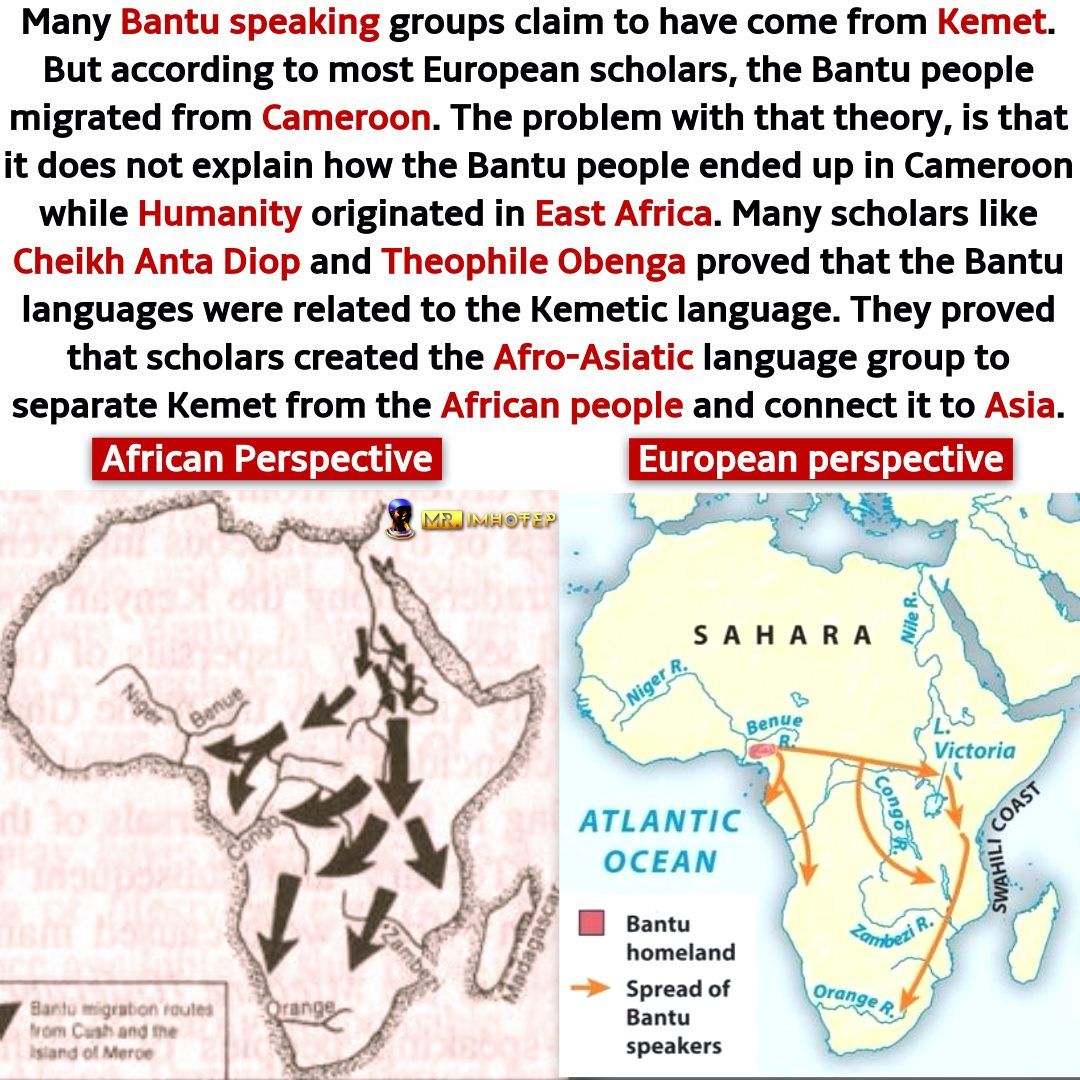
The same thing for Southern Africa as well
Ke Wang1*, Johannes Krause1,
Africa hosts the greatest human genetic diversity globally, but legacies of ancient population interactions and
dispersals across the continent remain understudied. Here, we report genome-wide data from 20 ancient sub-Saharan
African individuals, including the first reported ancient DNA from the DRC, Uganda, and Botswana. These
data demonstrate the contraction of diverse, once contiguous hunter-gatherer populations, and suggest the resistance
to interaction with incoming pastoralists of delayed-return foragers in aquatic environments. We refine
models for the spread of food producers into eastern and southern Africa, demonstrating more complex trajectories
of admixture than previously suggested. In Botswana, we show that Bantu ancestry post-dates admixture
between pastoralists and foragers, suggesting an earlier spread of pastoralism than farming to southern Africa.
Our findings demonstrate how processes of migration and admixture have markedly reshaped the genetic map
of sub-Saharan Africa in the past few millennia and highlight the utility of combined archaeological and archaeogenetic
approaches.
So again there was no fukking Bantu migration from Cameroon you fukking Cac plant

4. The Niger-Congo people left Egypt ~2500 years ago yet they grew none of the crops that Ancient Egyptians were known for. What happened, did the Ancient Egyptians just forget how to grow Niger-Congo crops like Millet, Cowpea, Yams, Rice, Melegueta Pepper etc once the Niger-Congo people left!? Did Niger-Congo people forget the many Ancient Egyptian crops!?
Well for if the crops did not come with them it would make a little bit o
Pearl millet - Wikipedia
Millet in Ancient Kemet
Millet | plant
your very first example is debunked, which discredits the rest of your asinine claims.
CAC ALERT CAC ALERT!!!
Last edited:
Dafunkdoc_Unlimited
Theological Noncognitivist Since Birth
- Joined
- Jul 25, 2012
- Messages
- 45,062
- Reputation
- 8,035
- Daps
- 122,417
- Reppin
- The Wrong Side of the Tracks

In 1976, Ivan Van Sertima proposed that New World civilizations were strongly influenced by diffusion from Africa. The first and most important contact, he argued, was between Nubians and Olmecs in 700 B.C., and it was followed by other contacts from Mali in A.D. 1300. This theory has spread widely in the African‐American community, both lay and scholarly, but it has never been evaluated at length by Mesoamericanists. This article shows the proposal to be devoid of any foundation. First, no genuine African artifact has ever been found in a controlled archaeological excavation in the New World. The presence of Africanorigin plants such as the bottle gourd (Lagenaria siceraria) or of African genes in New World cotton (Gossypium hirsutum) shows that there was contact between the Old World and the New, but this contact occurred too long ago to have involved any human agency and is irrelevant to Egyptian‐Olmec contact. The colossal Olmec heads, which resemble a stereotypical “Negroid,” were carved hundreds of years before the arrival of the presumed models. Additionally, Nubians, who come from a desert environment and have long, high noses, do not resemble their supposed “portraits.” Claims for the diffusion of pyramid building and mummification are also fallacious.

It begs so many questions.
1. Why only Niger-Congo speakers escaping?
Well here are the Nilo-Saharan speaking Kalejin who tell the exact same story;
"Between East Africa and Egypt
The Kalenjins of Kenya, Uganda and Tanzania had the role of defending Egypt,up to the time of Herodotus. When Herodotus visited Egypt during the 5th century BCE, he encountered a sub-nation of Egypt known as Sebenitus. Until the 40s, all Kalenjin were known by fourth names namely Sebei, Sabaot, Miot and Midian. Scholars from the community coined the word, Kalenjin, meaning I tell you to unite all the sub-nations of the tribe. Sebei and Sabaot now live around Mt. Elgon in Western Kenya and Eastern Uganda. It is possible that Herodotus misspelled the word, Sebenitus, which should have been either Sebei or Sabaot. Even the Bible confirms the presence of the Sebei (Kalenjin). Job 1:5 says "...and the Sabeans fell upon and took them away." Ezekiel also wrote about the Kalenjins (Sabeans), a sub-tribe of Ancient Egyptians. ze:23:42 says, "..and a voice of multitude being at ease was with her, and with the men of the common sort were brought Sabeans from the wilderness which put bracelets upon their hands and beautiful crowns upon their heads."
When Herodotus asked the Sebenitus people about where their aboriginal home was, they told him is/was a place called Nttr-the holy land of the God in the south. With the Benefit of Kalenjin language, we can learn that Ntrr was actually Tororo Hills in Eastern Uganda. Tororo means the exalted one, the high hill or even God. Hence Ntrr should be netoror-the exalted one!
According to their own accounts, the Kalenjin believe that their ancestors aboriginal home was here in Kenya at a place called Tororo Hills in Eastern Uganda. From here they migrated to Misiri or Egypt, where they stayed for thousands of years, and then migrated back again to Kenya. Some remained in Egypt. Others are in Ethiopia, Sudan, Eritrea and many other places around the world. However not all Old Egyptians (Kalenjin) left for Egypt. The Ogiek or Dorobo who speak Kalenjin do not recall having migrated from elsewhere. They say that they have been living in Kenya since time immemorial.
In 2001, I interviewed some oldmen as to why they left Egypt. They told me that they left Egypt after being attacked by a mysterious people called Kipyayamungeen. They said these people were white. (The term, "white", is a relative term, which means lighter skin color.) They say this was during the reign of Pharaoh Kipcheum. According to Dr Sambu, about 250,000 warriors left Egypt for East Africa as a result of this invasion. This event coincides with the first Persian invasion of Egypt, which occurred about 525 BCE.
Because the Kalenjin tongue is basically a dialect of the Egyptian language, many Egyptian words and names are recognizable by the Kalenjin peoples, such as:
For thousands of years, Egypt was known to the entire ancient world as Kagypta, meaning the sanctuary of Pta. Pta, now known as Kiptaiyat in modern Kalenjin language, was the deity of Memphis. When the Greeks came to Egypt about 2500 years ago, they could not pronounce the word Kagypta. Instead, they pronounced it as Aigyptos or Aegyptus. They also referred to people of Egypt as Kiptaios (see the word Kiptaiyaat above!).
The word, kmt, which the Egyptians referred to as their country, is also traceable to the Kalenjin tongue. Kemet in Kalenjin means country. Some other Egyptians called their country Khemet, which historians used to coin the word Hamites.
Pharaoh in Kalenjin language means a massively built house, a leader or president. In fact, Pharaoh should be written as Parao, from the words Para (meaning big or vast) and ooh or woor, meaning the big one. Parao should mean the leader of the entire nation. I say it should be Parao because the English word Empire is derived from it. Em in Kalenjin and Ancient Egyptian means country, while para or pire means wide, big or vast. Hence, the Europeans coined the word Empire and its derivatives from the word Parao or Pharaoh! The Kalenjin people have produced some of the Egyptian Pharaohs.
Pharaoh Amasis in Kalenjin may mean the one loved by God, the one who loves God, the one who eats God or the one who is eaten by God. Am in Kalenjin means eat, while Asista means the sun. There are many other examples.
The Kalenjin say that upon arrival in east Africa, they circumcised their boys in two places. They circumcised their boys near Mt Elgon at a hill called tulwop Kabiniet (ie the hill of Phallus).Around 1500 CE they circumcised their boys again at a hill called Tulwop Monyiseet (ie the hill of the foreskins). It is interesting to note that like their ancestors in Egypt, the Kalenjins gave functionally descriptive names to hills where circumcision rites have been performed. Remember God telling Jushua to circumcise his boys again in the hill of the foreskins (Joshua 5;3) in Gilgal area. Again the Kalenjin say that their ancestors used to circumcise their boys in Gilgil area which is 100 km west of nairobi. Gilgil is a corruption of Gilgal, which is the military base of the Kenyan Army.
Kalenjin Dieties
Like, Old Egyptians, Kalenjin was a monotheistic society. They believe in one God who has so many names. Asis is the deity of the Kalejin. This is Isis. Asis or Aset among the Barabaig of Tanzania was believed to be a woman. Other names we brought from Egypt include Illat-the God of Justice. Some other people later corrupted to Allah or Illay among the Somalis of Kenya and Ethiopia. Chebo-Amoni is another name of our deity which the Greeks corrupted to Amoni. The Kalenjin word osirun means to resurrect, to wake up from sleep or to cross a bridge. Apeso is also the name of our Deity, known as Apis.
The Kalenjin used to refer to themselves as children of Miot or Myoot, known in Ancient Egypt as Ma-at, another deity of Old Egyptians.
Kalenjin and Moses
The Bible tells us that Moses married a lady from Midian people known as Zipporah. I am now convinced that Moses was a Kalenjin since Moso in our language means a child. Moses was said to have been a child rescued somewhere in Egypt. We have songs about Moses in kalnjin. After circumcising our girls, we sing a song called, Ndomo rireet ab Mugaika koto mokimi emoni, ie if it were not for the sea of Musaiga (Moses) we would be dead. The story about Moses crossing the sea with his people is common among many tribes in Kenya and Southern Africa. This confirms that Moses was an Egyptian. Midian is a clan of the Kalenjins of Baringo district of Kenya.
Kalenjin and Sabeans
Sebenitus also refers to the people known as Sabeans. In fact it was the Sabeans of South Arabia who established the first civilization in the Arabian peninsula-thousands of years before the emergence of the Bedouin Arabs. Through the Sabeans (Kalenjin) link, it is not difficult to explain the presence of Old Egyptians from remote antiquity, in the Malayan Peninsula, Indo-China, and the heavy concentration of Old Egyptians in India, the Angkor and Champa in Southeast Asia, the vast populations of the dark-skinned peoples in Southern China as far as Japan's Ainu people.
It can be seen in retrospect that the Kalenjins are Old Egyptians what with more information coming to this site from me.
Kalenjin history should now be rewritten by its free natives (and not by the colonial powers of European academia), and its great past reconciled with that of other Old Egyptians around the world.
The Kalenjins of Kenya, Uganda and Tanzania had the role of defending Egypt,up to the time of Herodotus. When Herodotus visited Egypt during the 5th century BCE, he encountered a sub-nation of Egypt known as Sebenitus. Until the 40s, all Kalenjin were known by fourth names namely Sebei, Sabaot, Miot and Midian. Scholars from the community coined the word, Kalenjin, meaning I tell you to unite all the sub-nations of the tribe. Sebei and Sabaot now live around Mt. Elgon in Western Kenya and Eastern Uganda. It is possible that Herodotus misspelled the word, Sebenitus, which should have been either Sebei or Sabaot. Even the Bible confirms the presence of the Sebei (Kalenjin). Job 1:5 says "...and the Sabeans fell upon and took them away." Ezekiel also wrote about the Kalenjins (Sabeans), a sub-tribe of Ancient Egyptians. ze:23:42 says, "..and a voice of multitude being at ease was with her, and with the men of the common sort were brought Sabeans from the wilderness which put bracelets upon their hands and beautiful crowns upon their heads."
When Herodotus asked the Sebenitus people about where their aboriginal home was, they told him is/was a place called Nttr-the holy land of the God in the south. With the Benefit of Kalenjin language, we can learn that Ntrr was actually Tororo Hills in Eastern Uganda. Tororo means the exalted one, the high hill or even God. Hence Ntrr should be netoror-the exalted one!
According to their own accounts, the Kalenjin believe that their ancestors aboriginal home was here in Kenya at a place called Tororo Hills in Eastern Uganda. From here they migrated to Misiri or Egypt, where they stayed for thousands of years, and then migrated back again to Kenya. Some remained in Egypt. Others are in Ethiopia, Sudan, Eritrea and many other places around the world. However not all Old Egyptians (Kalenjin) left for Egypt. The Ogiek or Dorobo who speak Kalenjin do not recall having migrated from elsewhere. They say that they have been living in Kenya since time immemorial.
In 2001, I interviewed some oldmen as to why they left Egypt. They told me that they left Egypt after being attacked by a mysterious people called Kipyayamungeen. They said these people were white. (The term, "white", is a relative term, which means lighter skin color.) They say this was during the reign of Pharaoh Kipcheum. According to Dr Sambu, about 250,000 warriors left Egypt for East Africa as a result of this invasion. This event coincides with the first Persian invasion of Egypt, which occurred about 525 BCE.
Because the Kalenjin tongue is basically a dialect of the Egyptian language, many Egyptian words and names are recognizable by the Kalenjin peoples, such as:
For thousands of years, Egypt was known to the entire ancient world as Kagypta, meaning the sanctuary of Pta. Pta, now known as Kiptaiyat in modern Kalenjin language, was the deity of Memphis. When the Greeks came to Egypt about 2500 years ago, they could not pronounce the word Kagypta. Instead, they pronounced it as Aigyptos or Aegyptus. They also referred to people of Egypt as Kiptaios (see the word Kiptaiyaat above!).
The word, kmt, which the Egyptians referred to as their country, is also traceable to the Kalenjin tongue. Kemet in Kalenjin means country. Some other Egyptians called their country Khemet, which historians used to coin the word Hamites.
Pharaoh in Kalenjin language means a massively built house, a leader or president. In fact, Pharaoh should be written as Parao, from the words Para (meaning big or vast) and ooh or woor, meaning the big one. Parao should mean the leader of the entire nation. I say it should be Parao because the English word Empire is derived from it. Em in Kalenjin and Ancient Egyptian means country, while para or pire means wide, big or vast. Hence, the Europeans coined the word Empire and its derivatives from the word Parao or Pharaoh! The Kalenjin people have produced some of the Egyptian Pharaohs.
Pharaoh Amasis in Kalenjin may mean the one loved by God, the one who loves God, the one who eats God or the one who is eaten by God. Am in Kalenjin means eat, while Asista means the sun. There are many other examples.
The Kalenjin say that upon arrival in east Africa, they circumcised their boys in two places. They circumcised their boys near Mt Elgon at a hill called tulwop Kabiniet (ie the hill of Phallus).Around 1500 CE they circumcised their boys again at a hill called Tulwop Monyiseet (ie the hill of the foreskins). It is interesting to note that like their ancestors in Egypt, the Kalenjins gave functionally descriptive names to hills where circumcision rites have been performed. Remember God telling Jushua to circumcise his boys again in the hill of the foreskins (Joshua 5;3) in Gilgal area. Again the Kalenjin say that their ancestors used to circumcise their boys in Gilgil area which is 100 km west of nairobi. Gilgil is a corruption of Gilgal, which is the military base of the Kenyan Army.
Kalenjin Dieties
Like, Old Egyptians, Kalenjin was a monotheistic society. They believe in one God who has so many names. Asis is the deity of the Kalejin. This is Isis. Asis or Aset among the Barabaig of Tanzania was believed to be a woman. Other names we brought from Egypt include Illat-the God of Justice. Some other people later corrupted to Allah or Illay among the Somalis of Kenya and Ethiopia. Chebo-Amoni is another name of our deity which the Greeks corrupted to Amoni. The Kalenjin word osirun means to resurrect, to wake up from sleep or to cross a bridge. Apeso is also the name of our Deity, known as Apis.
The Kalenjin used to refer to themselves as children of Miot or Myoot, known in Ancient Egypt as Ma-at, another deity of Old Egyptians.
Kalenjin and Moses
The Bible tells us that Moses married a lady from Midian people known as Zipporah. I am now convinced that Moses was a Kalenjin since Moso in our language means a child. Moses was said to have been a child rescued somewhere in Egypt. We have songs about Moses in kalnjin. After circumcising our girls, we sing a song called, Ndomo rireet ab Mugaika koto mokimi emoni, ie if it were not for the sea of Musaiga (Moses) we would be dead. The story about Moses crossing the sea with his people is common among many tribes in Kenya and Southern Africa. This confirms that Moses was an Egyptian. Midian is a clan of the Kalenjins of Baringo district of Kenya.
Kalenjin and Sabeans
Sebenitus also refers to the people known as Sabeans. In fact it was the Sabeans of South Arabia who established the first civilization in the Arabian peninsula-thousands of years before the emergence of the Bedouin Arabs. Through the Sabeans (Kalenjin) link, it is not difficult to explain the presence of Old Egyptians from remote antiquity, in the Malayan Peninsula, Indo-China, and the heavy concentration of Old Egyptians in India, the Angkor and Champa in Southeast Asia, the vast populations of the dark-skinned peoples in Southern China as far as Japan's Ainu people.
It can be seen in retrospect that the Kalenjins are Old Egyptians what with more information coming to this site from me.
Kalenjin history should now be rewritten by its free natives (and not by the colonial powers of European academia), and its great past reconciled with that of other Old Egyptians around the world.
WELDON arap KIRUI, NAIROBI, KENYA"
See you don't know what the fukk you're talking about.Notice also these Nilo-Saharan speakers also point to the Persian invasion as the main reason for their abandonment of ancient Kemet, just like the Niger-Congo speaking groups and the listed books on page one assert;
.jpg)
2. Why are there practically no similarities between Ancient Egyptian and West African crops?
You were already debunked on Millets not being a commonalities between the times and places, but here are Yams (another one of your examples) as well;
Civilization and the Ancient Egyptians
We already know that Yam's are a staple in contemporary West African diets.
There's more but the fact of the matter is that the likelyhood of Asante's theory is incredibly low. Also Asante is dumb and deceitful arse clown.
You are a CAC troll who pretends to know African history when really you're entire purpose as on Egyptsearch to steer black people from knowing our heritage in ancient Kemet. Now go run off again little bytch.... CAC ALERT CAC ALERT.
Last edited:
Dafunkdoc_Unlimited
Theological Noncognitivist Since Birth
- Joined
- Jul 25, 2012
- Messages
- 45,062
- Reputation
- 8,035
- Daps
- 122,417
- Reppin
- The Wrong Side of the Tracks
DNA gleaned from a roughly 14,000-year-old fragment of a human tooth suggests that people inhabiting a surprisingly large swath of Asia were the ancestors of the first Americans.
This tooth, unearthed at a site just south of Lake Baikal in southern Siberia, provides the oldest known genetic link between Stone Age Asians and ancient American settlers, scientists report May 20 in Cell. Present-day Native Americans in North and South America are partly related to those early arrivals, the team says.
Link to study here:

20 findings confirming that blacks were in the Americas before Columbus.
1) The original Maya beginning with the Ocos , as illustrated by their the art, were Black Native Americans;
2) The Paleo-Americans were Blacks. The Black Native Americans lived from Chiapas to Belize, Guatemala and Hondurus; Quatrefages and Rafinesque wrote about these Blacks
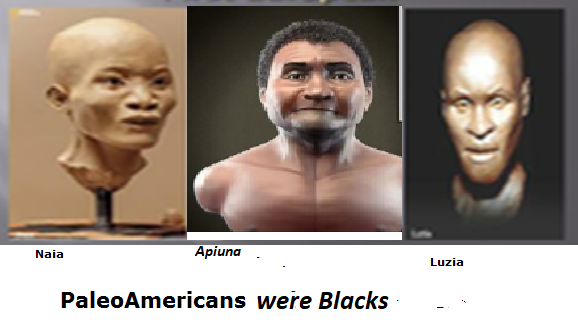
3) The root of the Mayan language is the Mande languages
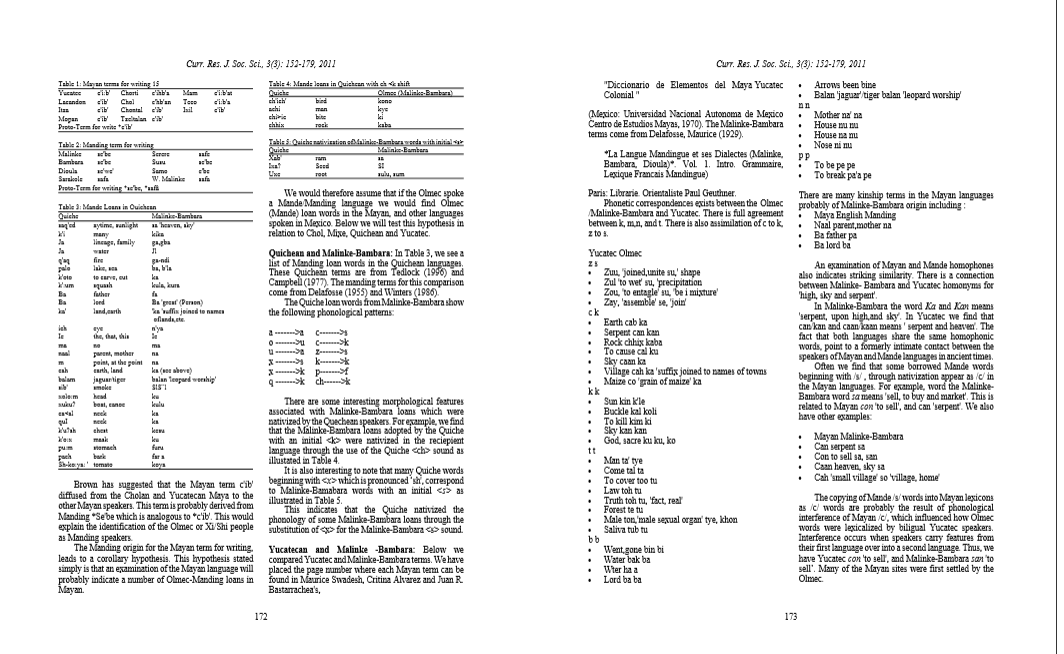
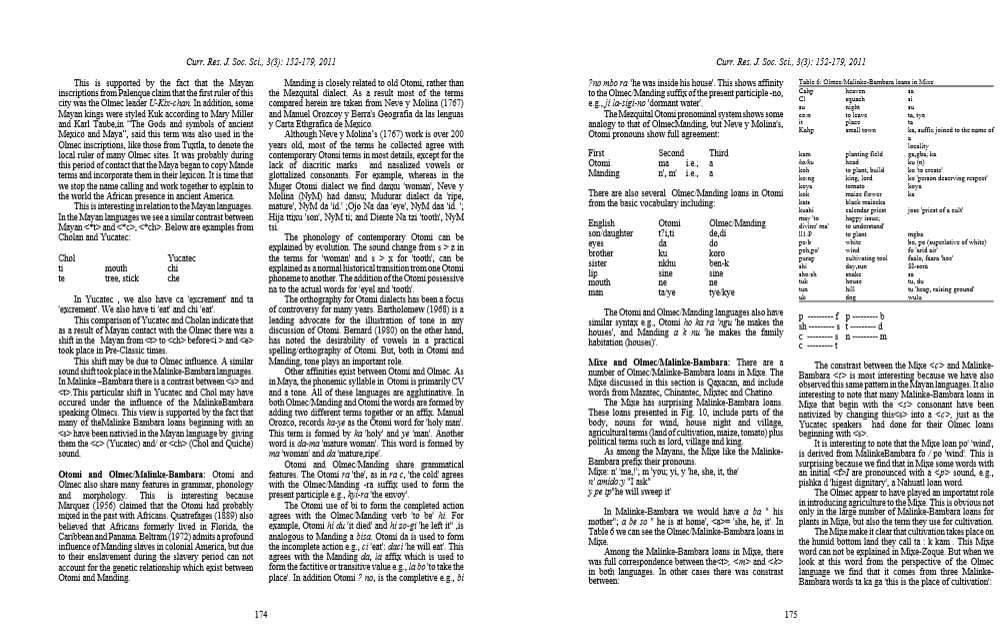
4) The first Americans based on skeletal remains : Naia and Luzia were Negroes or Black
5) Black Africans according to researchers have been in Brazil since 100,000BC
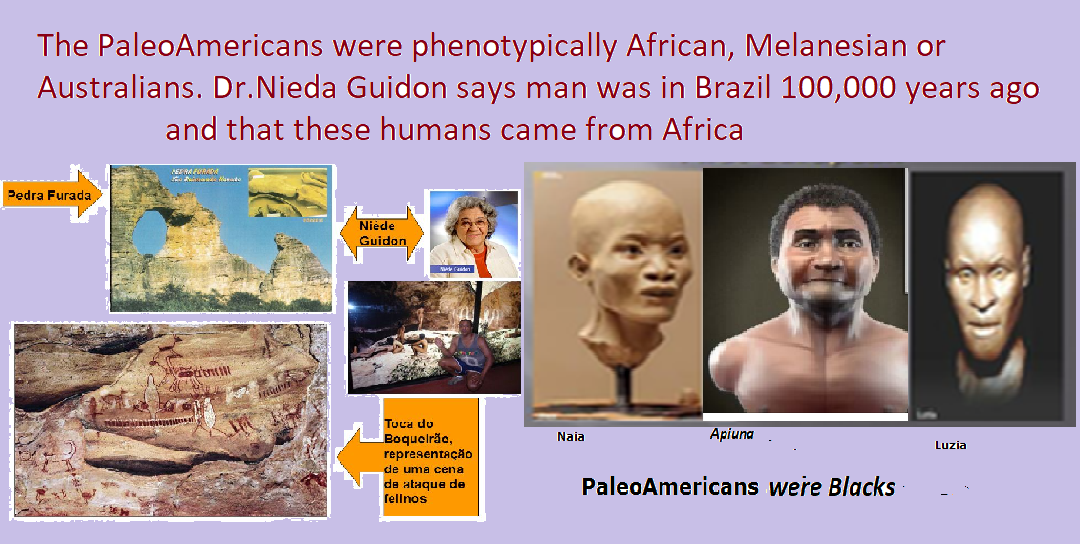
6) The Khoisan took MtDNA haplogroups N and y-haplogroup E to Eurasia and the Americas
7) There are no “pure” Mexindians. Lisker noted that between 5-50% of Indian genes are African genes. See: Suarez-Diaz,(2014) Indigenous populations in Mexico. Medical anthropology in the Work of Ruben Lisker in the 1960’s. Studies in History and Philosophy of Biological and Biomedical Sciences 47 (p.117).
8) Mixe, Zenu , Wayuu and other Mexican groups with YAP+ associated A-G transition at DYS271, is of African origin.
10) Indian y-chromosome haplogroups C and D show African admixture at locus DYS271
11) The American haplogroups A and B are part of the haplogroup N macrohaplogroup
Ch’ol and Chontal at Campeche carry R-M173, E1b1b, K and T.
12) Africans people carry mtDNA A common to mongoloid Native Americans and y-chromosome R, so they probably passed on these genes to mongoloid Native Americans
13) The Spanish explorers mentioned Black Nations and Black tribes in the Americas, they met, even before African slaves were landed in America
14) The Spanish said the Aztecs were Negroes.
15) The Olmec writing was brought from Africa to Mexico by the Mande
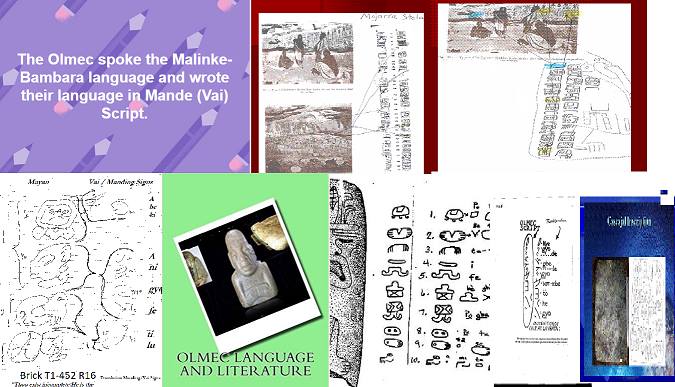
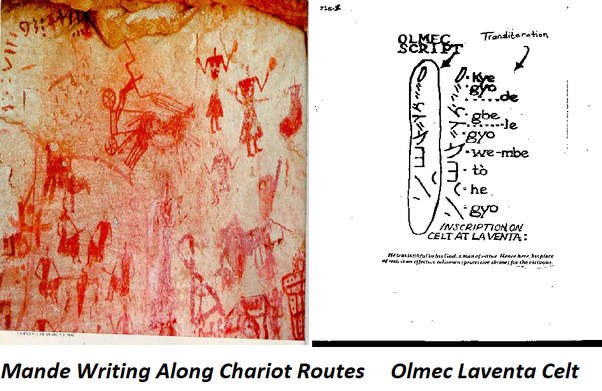
16. Vasco da Gama is said to have found information about the West Indies from Ahmad b. Majid, whom he met along the West Coast of Africa . Bazan, R.A.G. (1967). Latin America the Arabs and Islam,,Muslim World, pp.284-292.
17) The Mande built pyramids in Africa from Libya to the Niger Valley.
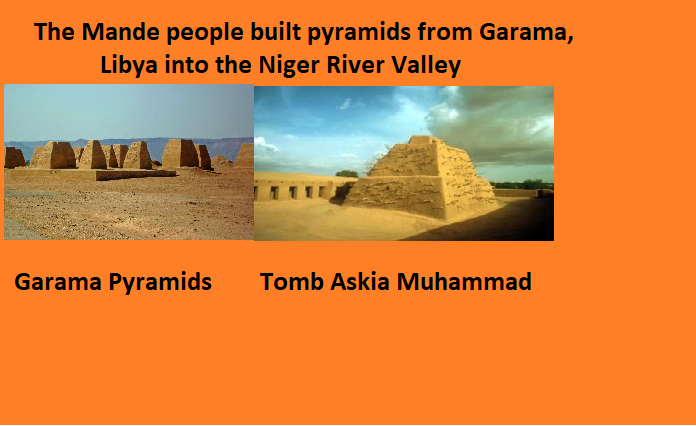
18) Africans had the boats capable of sailing to the Americas.
19) Black Native Mayan people have left iconography in the sub-pyramids at Tikal, San Bartolo and Xultun murals which depict the creators of these monuments as Negroes or Blacks
20) Ancient Mayan Skeletons carried sickle cell.
21. There are no “pure” Mexindians. Lisker noted that between 5-50% of Indian genes are African genes. See: Suarez-Diaz,(2014) Indigenous populations in Mexico. Medical anthropology in the Work of Ruben Lisker in the 1960’s. Studies in History and Philosophy of Biological and Biomedical Sciences 47 (p.117).
2) The Paleo-Americans were Blacks. The Black Native Americans lived from Chiapas to Belize, Guatemala and Hondurus; Quatrefages and Rafinesque wrote about these Blacks

3) The root of the Mayan language is the Mande languages


4) The first Americans based on skeletal remains : Naia and Luzia were Negroes or Black
5) Black Africans according to researchers have been in Brazil since 100,000BC

6) The Khoisan took MtDNA haplogroups N and y-haplogroup E to Eurasia and the Americas
7) There are no “pure” Mexindians. Lisker noted that between 5-50% of Indian genes are African genes. See: Suarez-Diaz,(2014) Indigenous populations in Mexico. Medical anthropology in the Work of Ruben Lisker in the 1960’s. Studies in History and Philosophy of Biological and Biomedical Sciences 47 (p.117).
8) Mixe, Zenu , Wayuu and other Mexican groups with YAP+ associated A-G transition at DYS271, is of African origin.
10) Indian y-chromosome haplogroups C and D show African admixture at locus DYS271
11) The American haplogroups A and B are part of the haplogroup N macrohaplogroup
Ch’ol and Chontal at Campeche carry R-M173, E1b1b, K and T.
12) Africans people carry mtDNA A common to mongoloid Native Americans and y-chromosome R, so they probably passed on these genes to mongoloid Native Americans
13) The Spanish explorers mentioned Black Nations and Black tribes in the Americas, they met, even before African slaves were landed in America
14) The Spanish said the Aztecs were Negroes.
15) The Olmec writing was brought from Africa to Mexico by the Mande


16. Vasco da Gama is said to have found information about the West Indies from Ahmad b. Majid, whom he met along the West Coast of Africa . Bazan, R.A.G. (1967). Latin America the Arabs and Islam,,Muslim World, pp.284-292.
17) The Mande built pyramids in Africa from Libya to the Niger Valley.

18) Africans had the boats capable of sailing to the Americas.
19) Black Native Mayan people have left iconography in the sub-pyramids at Tikal, San Bartolo and Xultun murals which depict the creators of these monuments as Negroes or Blacks
20) Ancient Mayan Skeletons carried sickle cell.
21. There are no “pure” Mexindians. Lisker noted that between 5-50% of Indian genes are African genes. See: Suarez-Diaz,(2014) Indigenous populations in Mexico. Medical anthropology in the Work of Ruben Lisker in the 1960’s. Studies in History and Philosophy of Biological and Biomedical Sciences 47 (p.117).
Black Americans come from west Africa.
Where do West Africans aka Niger-Congo speaking populations come from?
A bunch of questionable picture comparisons and charts don’t change that.
Don't do that....DNA evidence was presented right below those cultural comparison, but you don't have shyt to say about that. Classic gaslighting!
Respect the facts. And furthermore take pride in that history and culture. We don’t need Egypt.
Undercover Cac shut the fukk up!
Ozymandeas
Veteran
I believe it. I have West African ancestry mostly but I have like 5% in combined percentage from East Africa (Sudan), North Africa/West Asia (Egypt) and Southeast Africa (Swahili coast area). The only way that’s possible is one of my ancestors left that side of Africa and went West which is where I get my Ghanian, Nigerian, Congolese and Senegambian heritage from.
I believe it. I have West African ancestry mostly but I have like 5% in combined percentage from East Africa (Sudan), North Africa/West Asia (Egypt) and Southeast Africa (Swahili coast area). The only way that’s possible is one of my ancestors left that side of Africa and went West which is where I get my Ghanian, Nigerian, Congolese and Senegambian heritage from.
Your Ghanian, Nigerian, COngolese, and Senegambian ancestors also came from the East. Check the second post on here, which goes into detail about their paternal (male) DNA (the E-M2 marker) coming from East Africa as well.
nikkaz worship Egypt like whites worship rome
That's a false equivalence for one, and it further shows that you have never read the books mentioned on the first page.
BlackJesus
Spread science, save with coupons
Undercover Cac shut the fukk up!
Riiiiight. Very professional way to respond lol Mr self proclaimed Egyptologist.